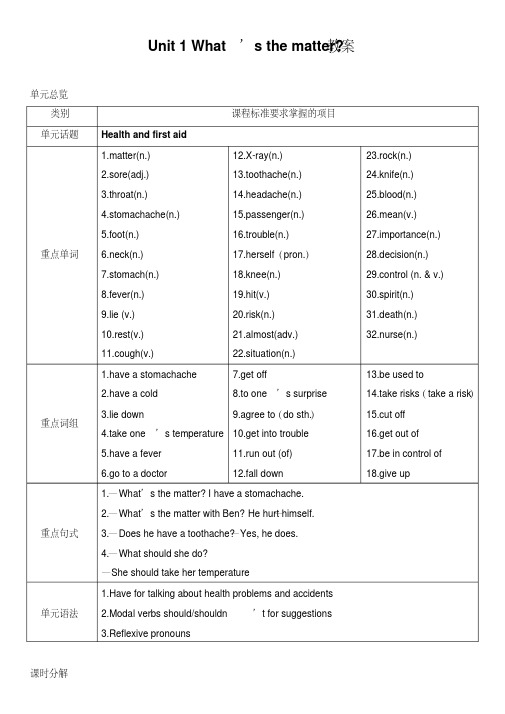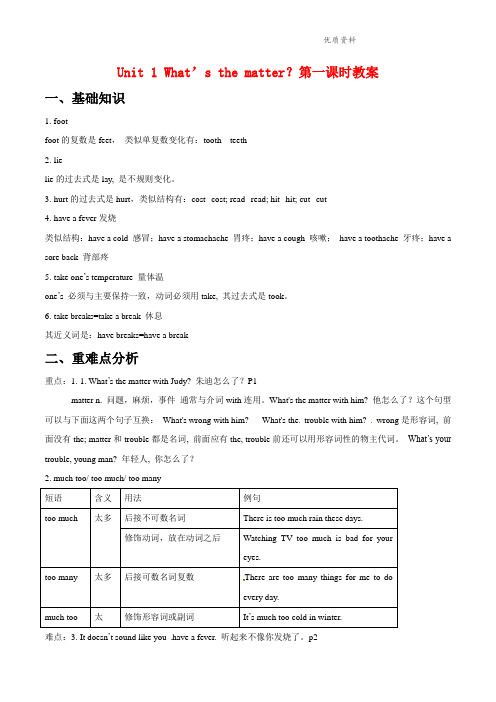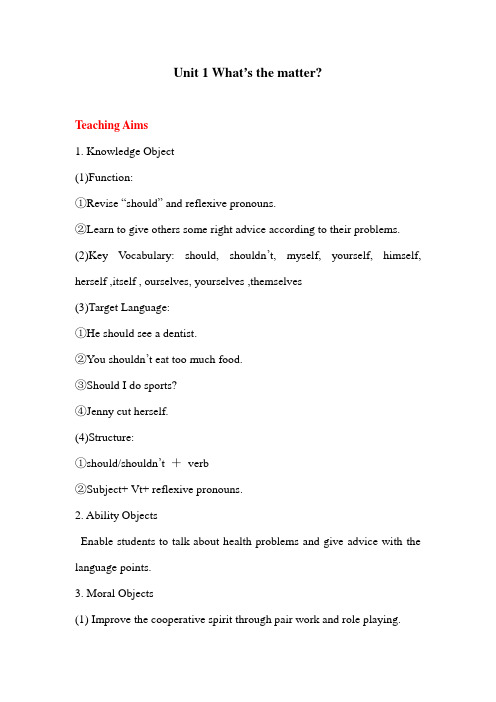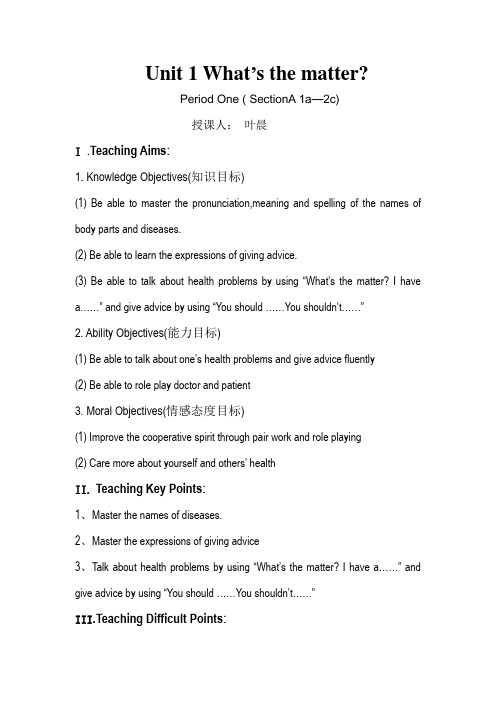Unit-1-what's-the-matter第一课时教学设计-1
- 格式:doc
- 大小:65.00 KB
- 文档页数:8

Unit 1 What’s the matter?教案单元总览类别课程标准要求掌握的项目单元话题Health and first aid重点单词1.matter(n.)2.sore(adj.)3.throat(n.)4.stomachache(n.)5.foot(n.)6.neck(n.)7.stomach(n.)8.fever(n.)9.lie (v.)10.rest(v.)11.cough(v.)12.X-ray(n.)13.toothache(n.)14.headache(n.)15.passenger(n.)16.trouble(n.)17.herself(pron.)18.knee(n.)19.hit(v.)20.risk(n.)21.almost(adv.)22.situation(n.)23.rock(n.)24.knife(n.)25.blood(n.)26.mean(v.)27.importance(n.)28.decision(n.)29.control (n. & v.)30.spirit(n.)31.death(n.)32.nurse(n.)重点词组1.have a stomachache2.have a cold3.lie down4.take one’s temperature5.have a fever6.go to a doctor7.get off8.to one’s surprise9.agree to(do sth.)10.get into trouble11.run out (of)12.fall down13.be used to14.take risks (take a risk)15.cut off16.get out of17.be in control of18.give up重点句式1.—What’s the matter? —I have a stomachache.2.—What’s the matter with Ben? —He hurt himself.3.—Does he have a toothache? —Yes, he does.4.—What should she do?—She should take her temperature单元语法1.Have for talking about health problems and accidents2.Modal verbs should/shouldn’t for suggestions3.Reflexive pronouns课时分解第一课时Section A(1a ~ 2d)知识目标类别课时要点重点单词matter(n.) 问题;事情sore(adj.) 疼痛的;酸痛的throat(n.) 咽喉;喉咙stomachache(n.) 胃痛;腹痛foot(n.) 脚;足neck(n.) 脖子;颈stomach(n.) 胃;腹部fever(n.) 发烧lie(v.) 躺;平躺rest(v.) 放松;休息cough(v.) 咳嗽X-ray(n.) X射线;X光toothache(n.) 牙痛headache(n.) 头痛重点词组have a stomachache 胃痛have a cold 感冒lie down 躺下take one’s temperature量体温have a fever发烧go to a doctor看医生重点句式What’s the matter? 你怎么了?I have a cold.我得了感冒。

Unit 1 What’s the matter?第一课时教案一、基础知识1. footfoot的复数是feet,类似单复数变化有:tooth---teeth2.lielie的过去式是lay, 是不规则变化。
3.hurt的过去式是hurt,类似结构有:cost--cost; read--read; hit--hit; cut--cut4.have a fever发烧类似结构:have a cold 感冒;have a stomachache 胃疼;have a cough 咳嗽;have a toothache 牙疼;have a sore back 背部疼5.take one’s temperature 量体温one’s 必须与主要保持一致,动词必须用take, 其过去式是took。
6.take breaks=take a break 休息其近义词是:have breaks=have a break二、重难点分析重点:1. 1. What’s the matter with Judy? 朱迪怎么了?P1matter n. 问题,麻烦,事件通常与介词with连用。
What's the matter with him? 他怎么了?这个句型可以与下面这两个句子互换:What's wrong with him? What's the trouble with him? wrong是形容词, 前面没有the; matter和trouble都是名词, 前面应有the, trouble前还可以用形容词性的物主代词。
What’s your trouble, young man? 年轻人, 你怎么了?2. much too/ too much/ too many短语含义用法例句too much 太多后接不可数名词There is too much rain these days.修饰动词,放在动词之后Watching TV too much is bad for youreyes.too many 太多后接可数名词复数There are too many things for me to doevery day.much too 太修饰形容词或副词It’s much too cold in winter.难点:3. It doesn’t sound like you have a fever. 听起来不像你发烧了。

unit-1-what's-the-matter-教案(jiào àn)unit-1-what's-the-matter-教案(jiào àn)Unit 1 What’s the matter?教材(jiàocái)解读Go for it! 是以任务型语言教学(jiāo xué)为基础的英语教材,它体现(tǐxiàn)“以学生(xué sheng)为中心”和“以人为本”的教学思想,融话题、交际功能和语言结构于一体。
本书每个单元都列出明确(míngquè)的语言目标、主要的功能项目和语法结构、需要掌握的基本词汇,并分为Section A和Section B两部分。
Section A为目标句型提供分步事例和指导性练习;Section B使学生能够对已经学过的目标句型运用自如。
每个单元还附有Self Check部分,此部分是让学生用来测试自己现阶段的英语水平,即对本单元的语言目标的掌握程度有较为明确的认识。
第1单元(dānyuán)以What’s the matter?为中心话题(huàtí),让学生认知表示身体部1位的单词以及部分疾病的表达方法,描述身体不适和提出建议展开,学习和运用“What’s the matter?”和“What should…do?”让学生学会描述身体的不适和提出建议。
本课教材内容与学生的实际生活密切相关,易于引出学生运用简单的英语进行交际和交流,在学习活动(huó dòng)中,学生通过交换对身体不适的描述及建议,促进学生之间和师生之间的情感交流,增进情谊。
同时,在学习中养成良好的健康习惯。
单元(dānyuán)目标一、知识(zhī shi)与技能1. 知识目标:认知表示身体部位的单词以及部分疾病的表达方法。

Unit 1 What’s the matter?Teaching Aims1. Knowledge Object(1)Function:①Revise “should” and reflexive pronouns.②Learn to give others some right advice according to their problems.(2)Key V ocabulary: should, shouldn’t, myself, yourself, himself, herself ,itself , ourselves, yourselves ,themselves(3)Target Language:①He should see a dentist.②You shouldn’t eat too much food.③Should I do sports?④Jenny cut herself.(4)Structure:①should/shouldn’t +verb②Subject+ Vt+ reflexive pronouns.2. Ability ObjectsEnable students to talk about health problems and give advice with the language points.3. Moral Objects(1) Improve the cooperative spirit through pair work and role playing.(2) Students care more about themselves and their family members’health.Teaching Key Points1. Revise the use of “should”.2. Revise the forms and use of reflexive pronouns.Teaching Difficult Points1. Revise the use of “should”.2. Revise the forms and use of reflexive pronouns.Teaching MethodsTask-based language teaching method, the cooperative learning method, and multimedia-assisted teaching and learning method.Teaching Aidsa computer, a projector, PPT and a blackboardTeaching ProceduresStep 1 Greetings and presenting the task of this period (about 1minutes) T: Boys and girls, today we’re going to revise the use of “should and the forms and use of reflexive pronouns.Step 2 Review (about 4minute)1. Students take out the paper and complete the sentences according to Chinese.①她应该干什么?_______ _______ she do?②他应该去看牙医。

Unit 1 What is the matter?Period 1 Section A (1a-2d)一、教学目标:1. 语言知识目标1) 能掌握以下单词以及短语:matter, sore, have a cold, foot, neck, stomach,throat, fever, lie,lie down, rest, cough, toothache, headache, break, hurt, enough water, takebreaks away from, all weekend, take one’s temperature, in the same way,go to a doctor, see a dentist, get an X-ray, cut oneself.2) 能熟悉以下句型:What’s the matter with…?”“What should I/ you/ he/ she/they… do?”“I/ you/ he/ she/they should do…”2. 情感态度价值观目标:教会学生关心他人,培养同学间团结、友善的精神。
二、教学重难点1. 教学重点:掌握相关的单词和词组,并能够灵活运用。
会使用以下句型:“What’s the matter with…?”“What should I/ you/ he/ she/they…do?”“I/ you/ he/ she/they should do…”2. 教学难点:学生对听力材料中新句型、新词组的理解。
三、教学过程Step1 Greet the whole class as usual.T: What’s the date today?/ What day is it today?/ How’s the weather?/ How was your weekend?/What do you usually do on weekends?/ Do you like exercising?/ How often do you exercise?/ That’s great! To do exercise can keep us healthy, but if we don’t pay attention to our health, there will be something wrong with our body. Now , look at these people.Learn some new words.Step2 引入一般过去时,对上学期所学知识进行复习。

Unit 1 What’s the matter?Period One ( SectionA 1a—2c)授课人:叶晨I .Teaching Aims:1. Knowledge Objectives(知识目标)(1) Be able to master the pronunciation,meaning and spelling of the names of body parts and diseases.(2) Be able to learn the expressions of giving advice.(3) Be able to talk about health problems by using “What’s the matter? I have a……” and give advice by using “You should ……You shouldn’t……”2. Ability Objectives(能力目标)(1) Be able to talk about one’s health problems and giv e advice fluently(2) Be able to role play doctor and patient3. Moral Objectives(情感态度目标)(1) Improve the cooperative spirit through pair work and role playing(2) Care more about yourself and others’ healthII. Teaching Key Points:1、Master the names of diseases.2、Master the expressions of giving advice3、Talk about health problems by using “What’s the matter? I have a……” and give advice by using “You should ……You shouldn’t……”III.Teaching Difficult Points:1、Students may find it difficult to remember all the target new words in the class2、Students may find it difficult to give appropriate advice to the certain disease because of their limited life experience.IV.Teaching AidsCards, a doll, pptV. Teaching Methods:1. Inferring vocabulary2. Role play ;Guessing game; Group and pair work3. Task-based teaching and situation-based teachingVI. Teaching procedures:Step1.Lead--in1. Enjoy a Chinese song: 健康歌2. The teacher(T) shows the doll bear and a picture of Pan Changjiang,point to the parts of the body3. Guessing a game : Listen and point the parts of bodyStep2. PresentionFinish 1a .1.Read the words about the parts of the body together.2.Write the correct letter [a-m] for each part of the body3.Invite a student to show your answer and the check it.Step3. Finish the four tasksTask 1 Look (望) and Listen (闻)Show the key vocabulary1.Learn the words and the phrases about illness. Have a cold/stomachache/headache/toothache/fever/sore throat/….2. Let’s match. Translation. Boys PK girls.3. Let’s act. Do and Say. See the doctor.First, the teacher hand out one phrase about illness to every group, then the teacher ask as a doctor ,“Cold, cold ,who has a cold ?” If the first group get the phrase “have a cold”, the SS in the group are doing action while answering,“Cold, cold, I have a cold.” .4. Let’s chantTask 2 Ask(问)Show the target languageFinish 1b&1c1. T: If you are a doctor, how to ask a patient?(T leads the Ss )Ss: --What’s the matter with…?/ What’s wrong with….?--I have…..T: What’s the matter the patie nts in the picture?Listen and then number the names[1—5]2. Ask a student to tell the answer, and then teacher checks it.3. Read after the tape, then read after the teacher, read together4. Pair work. Give Ss 4 minutes to make the conversations with their partnersaccording to 1b using the target language---What’s the matter with? ---She/He has …..Task 3Advice (切)Show how to give some adviceFinish 2a&2b1.T:Oh, my god ,I have a headache now. Do you know why ?S1: You have a cold.T : No, I don’t have a cold. I only have a headache. Guess again.S2 : You watched TV and played computer games too late last night.T: You’re so clever. Can you give me advice? You can use“You should …or You shouldn’t …” What should I do ?S2 :You should lie down and rest .T: But should I lie down and rest now ? Of course not. Because I am giving an English class now. What shouldn’t I do ?S3 : You shouldn’t watch TV or play computer games too much .T: Thank you for your advice.2. Listening practice(1)Listen for the first time, number the pictures [1--5]in the order you hearthem .For the second time, match the problems with the advice.(2)Check the answers and read after the tape.Task 4 Internship (实习)Finish 2c. Speaking practiceGroup workTwo or three Ss in a group make conversations according to the example in 2c or in the screen. Give Ss 5 minutes and then act out.Step 5 Summary and ConsolidationLet’s summarize what we’ve learned. Today we’ve learned some parts of our body and learned how to ask the patients and give them advice. Please pay attention to the modal word should .No matter what your advice is, you must use should or shouldn’t. Let’s enjoy the sentences :(1)We shouldn’t watch TV or play computer games too much .(2) An apple a day keeps a doctor away. (3) Health is more important than wealth.Step6 Homework1. Remember the words and the phrases about illness2. Write some advice on keeping healthy.。
Unit 1 What’s the matter?Ⅰ.Teaching Aims and Demands1.Knowledge Objects(1)Key V ocabularyclean up, hunger, homeless, cheer up, give out, volunteer, food, bank(2)Target Languagehave for talking about health problemsWhat’s the matter?I have a headache.Y ou should drink some tea. That sounds like a good idea.I have a sore back. That’s too bad.I hope you feel better soon.2.Ability Objects(1)Train the students to express offering to help with the target language.(2)Train the studen ts’ listening skill.3.Moral Object Offer help to the others as much as possible.Ⅱ.Teaching Key Points1.Key V ocabularyclean up, hunger, homeless, cheer up, give up2.Target LanguageHow to express offering to help with target language.Ⅲ.Teaching Difficult Points1.Teach the students how to talk about health problems and accidents 2.Teach the students to give advice.3.Modal should/shouldn’tⅣ.Teaching Methods1.Teaching by giving sample sentences and making up sentences.2.Teaching by showing pictures.V. Learning strategies Using what you know, Inferring contentⅤI.Teaching Aids1.A tape recorder2.Some pictures on volunteer’s offering helpVI. Teaching times 10 periodsPeriod 1Step 1 Warming up by learning grammarTo begin wi th, go to page 8, and let’s learn to use have for talking about health problems and modal verbs should/shouldn’t.I have a headache. Y ou should go to bed.He has a stomachache. He shouldn’t eat anything.She has a toothache. She should see a dentist.Step 2 Now let’s read the words together.Keeping healthy is very important. So today we will talk about it. Let’s look at Unit 1 What’s the matter?1A Writing the lettersactivity individually.Let’s check the answer, please.Step 3 1b Listening and numberingCan you tell what part of the body doesn’t feel good? Now let’s learn the new words in the picture. Please read after me.Good. Let’s listen to the recording. There are conversations about each of these five students. Look at the picture and find the people that are being talked about. Listen to the tape and write the number next to them in the picture next to their names. The first one has been done for you.Let’s check the answers, please.Answers Nancy=3 Sarah=1 David=2 Ben=5 Judy=4Step 4 1c Doing pairworkCan you express what part of the body doesn’t feel good now? Work in pairs. Make your own conversations out of the picture on page 7. Then present your conversations to the whole class, using have for talking about health problems.A: What's the matter? B: I have a sore throat.Step 5 Summary A: What's the matter?B: I have a sore throat.Step 6 Homework Copy the new words and make some conversations with your partner.Prepare for a dictation.Step 7 Blackboard designPeriod 2Step Ⅰ Revision1.Revise the language points.A;What’s the matter? B;I have a headache 2. Have a dictation2. Have a dictation3.Check homework by asking some students to read their sentences they’ve made with the verbs.Let them hand in their homework.Step 2 2a Listening and matchingTaking care of your friends or family member is very important. Now please look at page 8, 2a. Read the eight items in this activity. When you read you must call attention to the meaning of the new words.Then listen to the recording. On this recording there are four different conversations. People are talking about health problems they have and are getting advice for them. Draw lines to match the problems with the advice.The first time, you only listen. The first one has been done for you. The boy has a toothache and the advice is to see a dentist.The second time, you draw lines to match the problems and the advice.Step 4 2b Listening and fillingStep 5 2c Doing pairworkNow let’s look at a conversation. Who wants to read it to the class? Y ou two, please.Step 6 Summary A: What's the matter?B: I have a sore throat.Step 7 Homework Copy the new words and make some conversations with your partner.Prepare for a dictation.Step 8 Blackboard designPeriod 3Step Ⅰ Revision1.Revise the language points.A; What’s the matter? B;I have a headache2. Have a dictation3.Check homework by asking some students to read their sentences they’ve made with the verbs.Let them hand in their homework.Step 2 learn the new wordsStudents spell the words first, Then read the words together.Get some students to read the words.Step 3 readingRead the passage. Do you think it comes from a newspaper or a book? How do you know? Read the passage and finish 3b and 3c in 15 minutes,True or fals1. The passenger saw an old man lying on the side of the road. ( T )2. The old man had a heart problem. ( F )3. Some passengers didn’t help Mr. Wang to move the man on the bus. ( T )4. At last, the doctors saved the man in time. ( F )5. One passenger says, “people often don’t want to get into trouble.” ( T )Read the passage and finish 3b and 3c in 15 minutes,3b Read the passage again and check (√) the things that happened in the story.1. __√_Wang Ping was the driver of bus No. 26 at 9:00 a.m. yesterday.2. ____ Bus No. 26 hit an old man on Zhonghua Road.3. __√The old man had a heart problem and needed to go to the hospital right away.4. ____ The passengers on the bus did not want to go to the hospital, so only Wang Pingwent with the woman and old man.5. _√_ Some passengers helped to get the old man onto the bus.6. ____ The old man got to the hospital in timeStep 4 SummaryWhat’s the matter? 的同义句:What's wrong (with you)?What's the trouble (with you)?What's up (with you)?Step 5 Homework Copy the new words and make some conversations with your partner.Prepare for a dictation.Step 6 Blackboard designPeriod 4Step ⅠRevision1.Revise the language points.A; What’s the matter? B;I have a headache2. Have a dictation3.Check homework by asking some students to read their sentences they’ve made with the verbs.Letthem hand in their homework.Step 2 learn the new wordsStudents spell the words first, Then read the words together.Get some students to read the words.Step 3 Grammar FocusRead the sentences情态动词shouldshould 应该, 应当①表示建议She is tired. She should go to bed early. 她很累, 应该早点上床睡觉。
八年级(下)Unit1 What’s the matter?Section A1、教材分析:本课是一堂口语课,学习对象为八年级生。
本课的话题选自八年级(下)Unit 1 What’s the matter? Section A在学习了身体各部分单词的基础上,要求学生学会谈论自己及他人的健康状况,本课的核心语言项目是“Ask and answer about health”。
学会用“What’s the matter?”来询问他人身体状况。
通过教师丰富的肢体语言使用让学生了解本课的教学重点-疾病的表达方式,从视觉上激起了学生的好奇心和求知欲。
通过结对练习,游戏和角色扮演等多种任务的训练巩固所学的基础语言材料:I have a … You should/shouldn’t…让学生有更多发挥的空间,创造口语练习2、学情分析:年级是学习英语的关键时期,这个阶段的学生活泼、好奇心和求知欲望强。
比如像本课所涉及的有关健康的话题是他们之前从未接触过的,因此,他们渴望用英语来表达。
另外,八年级学生的心理特点反映在学习英语的能力上,他们模仿和记忆的能力特别强。
1、教学目标设计:用具体、明确、可操作的行为语言,描述本课的知识、技能、能力、方法、情感、态度、价值观等方面的教学目标。
Objectives: By the end of the session, most students will be better able to acquire the required information.will be achieved by:1. Knowledge Objectives:1) Be able to master the pronunciation, meaning and spelling of the names of diseases: fever, sore throat, sore back; stomachache, headache, toothache, cold, cough;2) Be able to learn the expressions of giving advice: lie down and rest, drink hot tea with honey, see a dentist, takemedicine;3) B e able to talk about health problems by using “What’s the matter? I have a…” and give advice by using “You should…You shouldn’t…”2. Ability Objectives:1) Be able to talk about one’s health problems and give advice fluently;2) Be able to role play doctor and patient;3. Moral Objectives:1) Improve the cooperative spirit through pair work and role playing2) Care more about yourself and your family members’ health.5、重点难点设计:由于本节课的话题是谈论健康,根据教学大纲的要求,学生需掌握有关疾病的单词,并能针对疾病提出合理的建议。
因此本节课教学重点设置如下:The teaching Focus1. Master the names of diseases: fever, sore throat, sore back;stomachache, headache, toothache, cold, cough2. Master the expressions of giving advice: lie down and rest, drink hot tea with honey, see a dentist, take medicine;3.Talk about health problems by using “What’s the matter? I have a…”and give advice by using “You should… You shouldn’t…”The Teaching Difficulties1. Students may find it difficult to remember all the target new words in the class;2. Students may find it difficult to give appropriate advice to the certain disease because of their limited life experience.6、教学策略与手段:1.学生的学习准备;2.教师的教学准备;3.教学环境的设计与布置;4.教学用具的设计和准备。
7、教学过程:这是教学设计的主体部分。
分几个环节具体说明教学活动的安排,包括学生学习活动、教师指导活动、师生交互活动。
应采用文字叙述加点评的格式,不要采用表格或流程图的形式。
Step1 Warming upGreet Ss by asking them: How are you today? Then I’ll tell Ss that I’m not feeling well today the sentence on the blackboard and guide Ss toread it.) andSs to guess the reason freely. If Ss can’tthe answer, I’ll tell them that I didn’t have a go od sleep last night. So I have a headache. (I sayby doing a gesture)设计说明:通过师生间的问候,拉近彼此的距离,使学生快速融入英语课堂。
要求学生猜测老师身体不适的原因,从而激发学生的背景知识,并为之后的知识输入做好铺垫。
Step2: Presentation of words about diseases1. Show Ss a bandage and tell them there is something wrong in the place where the bandage lies. Then Ss to guess the health problems. When I do an action, ask Ss: “What’s the matter?” it on the blackboard) For example, when I put the bandage on the stomach, ask Ss: “What’s the matter with me?” Help Ss say: “I’m not feeling well. I have a stomachache.” Then teach the other target words: fever, sore throat, toothache, sore back in the following way: Put the bandage on the other part of body and students to ask: What’s the matter? Then other Ss to guess the problem.2. Use body language to guide Ss to guess another two names of diseases: cold, cough.3. Show Ss pictures of diseases half hidden, and Ss to guess the names of diseases: fever, sore throat, toothache, sore back, cold, cough.设计说明:老师在课堂上出示医疗用具-绷带,能充分唤起学生的好奇心,使其积极地参与到教学活动中。
通过绷带所绑的不同位置和肢体语言,自然地引出有关疾病的单词。
这种教学单词的方式简单而且直观,更易被学生接受。
八年级学生喜欢猜测的活动,所以,运用半遮图片可以让学生巩固所学的单词。
Step3: Pair workPut the bandage on the part of a student’s body and ask: “What’s matter?” and guide him to use the pattern: I’m not feeling well. I have a… Then ask Ss to work in pairs and talk about health probl ems by using the bandage given and using the target language: What’s the matter? I’m not feeling well. I have a …设计说明:八年级学生的表演欲望强,所以,在结对活动中,为每一小组提供绷带,这样可以激发学生的参与性,扩大参与面,使更多的学生开口说英语。
Step4 Presentation of expressions of giving advice1. Tell Ss that I have a cold/cough, ask them: What should I do? Ss may give different answers, collect their answers and help them to use: You should/shouldn’t do… Then show some pictures of other diseases mentioned before and ask them to give advice to each problem by using target language: You should/shouldn’t do… During activity, some phrases will be learned: lie down and rest, drink hot tea with honey, see a dentist, drink lots of water, take some medicine.2. Show Ss two bags. In one bag, there are pieces of paper with problems while in the other one, there are pieces of paper with advice. Have acompetition between boys and girls. Take turns to paper. For example, one boy gets one paper with problem, and one girl one paper with advice. The girl should say: What’s the mat ter with you? The boy should answer the question according to the problem he got by saying: I’m not feeling well. I have a…If the girl got the right advice, she should answer it according to her paper: You should… If it is not, she should say: You shouldn’t, then give the right advice. The one who makes right sentence can onepoint.设计说明:向学生展现有关疾病的图片,这样不仅可以帮助学生复习新知,而且还可以自然地引入新的话题—针对疾病给建议。